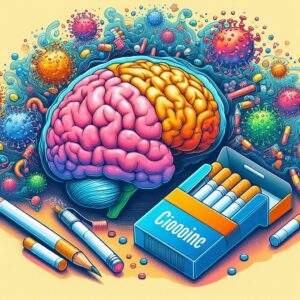
Exercise Daily _ Can Nicotine Patches Really Help with Long COVID Brain Fog? (A No-Hype Review for Athletes & Fitness Enthusiasts)
“Could Nicotine Patches Treat Long COVID?”.
What This Post Covers
- What Long COVID “brain fog” actually means for performance and cognition.
- Why scientists are probing nicotinic acetylcholine receptors (nAChRs) and the cholinergic anti-inflammatory pathway.
- What tiny case reports and lab data say—and don’t say—about nicotine patches.
- How nicotine can affect reaction time, attention, and decision-making under fatigue.
- Serious risks (addiction, side effects) and rules for athletes (WADA status, team policy).
- Low-risk alternatives to try first, plus where affiliate products responsibly fit.
Long COVID Brain Fog: Why Athletes Should Care
“Brain fog” isn’t just a vibe—it shows up as measurable hits to memory, attention, processing speed, and executive function, the very tools athletes need for game IQ, decision-making in traffic, and pacing strategies. Large academic groups worldwide continue to map these deficits months after infection. Even modest cognitive drag can disrupt an otherwise clean training block, especially when you combine travel, sleep debt, and competition stress. In short: if you feel “half a step slow” mentally, you’re not imagining it—and you’re not alone.
Why Nicotine, of All Things?
The scientific hook centers on nicotinic acetylcholine receptors (nAChRs), which regulate neural signaling and aspects of inflammation. Several mechanistic papers—ranging from in-silico work to molecular and review articles—have proposed that SARS-CoV-2 may interact with or dysregulate these receptors. That led some researchers to hypothesize that nicotine (an nAChR agonist) could help normalize signaling in specific contexts. For a deeper dive on the receptor discussion in the post-COVID landscape, see this 2025 review in Bioelectronic Medicine:
Leitzke et al., 2025.
There’s also the cholinergic anti-inflammatory pathway, a neural reflex that can dampen excessive cytokine release. Classic work in neuroimmunology has shown how acetylcholine signaling can modulate inflammation; nicotine can touch parts of that circuitry, at least in theory. That doesn’t make nicotine “anti-inflammatory medicine”—it means there’s a plausible biological lane to test in controlled trials.

What the Evidence Actually Says (Tiny, Early, Mixed)
The data most often cited is a small case series reporting symptom relief in Long COVID patients who used low-dose nicotine patches. It’s intriguing and worth reading—but it’s low on the evidence ladder (no control group, few patients). Translation: hypothesis-generating, not proof. Here’s the open-access paper:
Leitzke, 2023 – “Hypothesis: Nicotine for the treatment of post-COVID-19 condition”.
You’ll also find clinician interviews and patient anecdotes (for example, Health Rising’s community report describing improvement with a 7 mg patch over the first week):
Health Rising: Nicotine Patch & Long COVID. Anecdotes can help generate research questions, but they aren’t substitutes for randomized trials with objective outcomes and follow-up.
Bottom line: the “nicotine patch for brain fog” idea is in the early exploration stage. If future blinded trials show consistent, clinically meaningful benefits with acceptable risks, it would be a big deal. Until then, any experimentation should happen only with your physician’s supervision.
Performance Angle: Nicotine & Cognition in Non-Smokers
Separate from Long COVID, researchers have studied nicotine’s acute effects on cognition in healthy non-smokers for decades. Several controlled experiments suggest that low doses can sharpen certain tasks (e.g., sustained attention, simple reaction time), while higher doses can impair performance (jitters, over-arousal). If you want a grounding review, start with Wignall & de Wit’s summary on non-smokers:
Wignall & de Wit, 2011 (review), and a broader synthesis here:
Heishman/Valentine et al., 2018 (review).
One oft-quoted study found that nicotine gum shortened reaction time versus placebo:
Ernst et al., Molecular Psychiatry. A more recent meta-analysis from sports nutrition researchers reported improvements in response time, fine motor control, and some attention measures with nicotine in certain protocols:
Hung et al., 2021 (JISSN).
The catch? Individual responses vary a lot; benefits tend to be task-specific; and dose matters. Think U-shaped curve, not “more is better.”
Athlete Rules: Is Nicotine Banned in Sport?
As of today, nicotine is not on WADA’s Prohibited List, but it is included in the World Anti-Doping Agency’s Monitoring Program (meaning they track usage patterns and could revisit policy). Always confirm with your sport’s governing body and your club’s medical staff before using any nicotine product. See WADA’s current lists and notes here:
WADA Prohibited List and
Monitoring Program.
Real Risks & Who Should Avoid Nicotine
Let’s say this plainly: nicotine is addictive. Adolescents and young adults are especially vulnerable to dependence and to cognitive/behavioral harms from exposure during brain development. Authoritative public-health sources are clear on this point. For overviews, see CDC’s youth nicotine pages
(CDC – Youth & Tobacco) and FDA safety information on Nicotine Replacement Therapy (NRT)
(FDA – NRT Consumer Update).
A concise summary of developmental concerns is here:
Effects of nicotine on human brain development.
Side effects from patches can include skin irritation, vivid dreams, nausea, palpitations, and elevated blood pressure. Follow product instructions, keep patches away from children and pets (even used patches), and discuss cardiac history or psychoactive meds with your doctor before any trial. Basic consumer-level guidance:
Mayo Clinic – Nicotine Patch Side Effects and
MedlinePlus – Nicotine (transdermal).
Finally, do not confuse clinician-supervised, short-term, low-dose patches with vaping or oral pouches in non-smokers. Vaping and high-nicotine pouches can drive rapid dependence and are not FDA-approved cessation tools.
If You’re an Adult Athlete Discussing This with Your Doctor: A Conservative Test Sketch
This is not a recommendation—just a plain-English outline of what a cautious, physician-supervised experiment might look like for an adult with documented Long COVID brain fog and no contraindications.
- Baseline first: record repeatable cognitive markers (e.g., Trail Making Test, simple and choice reaction time apps), plus HRV, resting HR, BP, and sleep for 5–7 days.
- Start tiny: your clinician may consider the lowest practical dose (often 7 mg patch). Avoid stacking with caffeine at the start.
- Timing: test on non-competition days first. Some remove the patch before sleep to reduce vivid dreams.
- Training pairing: begin with low-intensity skill work and decision-making drills under mild fatigue; log perceived clarity and any side effects.
- Time-box it: if you don’t see clear, repeatable benefits within 1–2 weeks—or if side effects appear—stop and reassess with your clinician.
Lower-Risk Alternatives to Try Before Nicotine
- Sleep pressure: earlier lights-out; bright light within 60 minutes of waking; 10–20 minute outdoor walks mid-day for circadian anchoring.
- Anti-inflammatory basics: Mediterranean-leaning meals, omega-3 fish 2–3×/week, progressive aerobic volume, and strength maintenance (not PR-hunting) during recovery.
- Task-specific drills: dual-task footwork, reactive agility with visual/auditory cues, metronome-paced tempo work to challenge working memory.
- Caffeine periodization: consistent, modest intake on key sessions rather than “rescue mega-hits.” Re-evaluate tolerance monthly.
- Medical options: For tobacco users trying to quit (separate topic), discuss FDA-approved cessation meds such as varenicline or bupropion with your clinician (see FDA overview:
FDA – Quitting Smoking).
Where Our Affiliate Products (Responsibly) Fit
If—and only if—you and your clinician are evaluating low-dose NRT specifically for Long COVID symptoms, the following can act as structured tools. We include them for research completeness; they are not for youth, pregnancy, or non-smokers seeking “focus hacks.”
As an Amazon Associate, Exercise Daily earns from qualifying purchases. This post may contain affiliate links. Last updated: October 22, 2025
Non-Nicotine Complements
- Omega-3 fish oil, magnesium glycinate (sleep), and L-theanine (with caffeine) are common evidence-informed stacks; discuss with your clinician if you have conditions or meds.
- Remember: supplements are not FDA-approved to treat Long COVID.
The Debate (Tell-It-Like-It-Is)
Pro (researchers’ angle): If SARS-CoV-2 perturbs nAChR signaling, carefully dosed nicotine could—in theory—help restore function and reduce inflammatory noise for a subset of patients. Case observations show enough signal to justify trials (Leitzke, 2023), and mechanistic reviews outline plausible pathways
(Leitzke et al., 2025).
Con (public-health & coaching angle): Nicotine is addictive, risky for youth, and messy from a team-culture standpoint. Without randomized trials, benefits remain uncertain and placebo is real. Dependence can nuke long-term performance, sleep quality, and mental health—especially if a short “trial” drifts into daily use. See youth risk overviews from
CDC and
FDA.
Exercise Daily’s position: If you’re an adult athlete with documentable Long COVID brain fog, you may discuss a time-boxed, lowest-dose, physician-supervised patch after exhausting low-risk options. For everyone else—especially non-smokers and youth—don’t start nicotine for “focus.” It’s not a biohack; it’s a dependency risk with thin upside.
Quick Answers for Coaches & Athletes
- Is nicotine banned? Not currently on WADA’s Prohibited List, but on the Monitoring Program. Check:
WADA Prohibited List /
Monitoring Program. - Does it help brain fog? A small case series and anecdotes suggest “maybe.” We need controlled trials:
Leitzke, 2023. - Can it sharpen reaction time? Low doses sometimes improve specific tasks; higher doses can impair:
Wignall & de Wit,
Ernst et al.,
Hung et al. - Biggest risks? Addiction, cardiovascular and neuropsychiatric side effects, sleep disruption; secure patches away from kids and pets:
MedlinePlus,
Mayo Clinic. - What should I try first? Sleep, anti-inflammatory basics, cognitive-skill drills, and a medical consult. Consider legal/league policy before anything else.
Further Reading & Sources
- Verywell Health – Nicotine Patches & Long COVID (overview)
- Leitzke, 2023 – Hypothesis/Case Series: Nicotine for Post-COVID Condition
- Leitzke et al., 2025 – nAChR & Post-COVID Mechanisms (review)
- Wignall & de Wit, 2011 – Nicotine’s Cognitive Effects in Non-Smokers (review)
- Heishman/Valentine et al., 2018 – Meta/Review: Cognition & Nicotine
- Ernst et al. – Nicotine Gum & Reaction Time (Molecular Psychiatry)
- Hung et al., 2021 – Nicotine & Cognitive-Motor Performance (JISSN)
- World Anti-Doping Agency – Prohibited List
- World Anti-Doping Agency – Monitoring Program
- CDC – Youth & Tobacco
- FDA – Consumer Update on NRT
- MedlinePlus – Nicotine (Transdermal Patch) Drug Info
- Mayo Clinic – Nicotine Patch Side Effects
- Health Rising – Patient Anecdote on Long COVID & Nicotine Patch
- Effects of nicotine on human brain development (overview)













